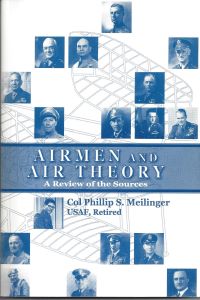- AFHF Member Authors
Airmen and Air Theory: A Review of the Sources
by Phillip Meilinger
The involvement of people has given history its enduring fascination and popularity. One field within history, biography, has always held special appeal. All of us have a deep interest in knowing how others, perhaps like ourselves, have met challenges, dealt with failure, and accommodated themselves to victory and fame. On a more mundane level, we like to know how great people lived their day-to-day lives and how they handled their loves, shortcomings, attributes, frailties, and quirks. We find comfort in knowing that great men and women were quite human. This knowledge also provides hope and encouragement because it means that even the humblest of us can aspire to greatness.
Certainly, geniuses live among us, but the lives of most of the ones we consider noteworthy are marked by an unexceptional background and a fortuitous turn of events. Sincere, hardworking, and courageous people find themselves in positions of responsibility when circumstances of great pith and moment are thrust upon them. Predicting how individuals will react in such circumstances is remarkably difficult. Often, people groomed for leadership are found wanting in times of crisis, and those who do step forward come from unexpected quarters. Such has been the case with many of our country’s great airmen.
This part of the book reviews the state of American airpower biography and autobiography. I have set certain parameters to define the boundaries of my discussion. I discuss biographies and autobiographies, anthologies, and oral histories of military officers who served in senior positions. Thus, although the stories of great aviators like Eddie Rickenbacker, Charles Lindbergh, and Chuck Yeager are important, those men did not command large forces either in combat or in peace; they had only a temporary effect on the development of strategy and doctrine. Similarly excluded are civilian political leaders and industrialists like Stuart Symington and Donald Douglas, 3 even though they played key roles in their own spheres. What follows are the stories—some published, some not—of America’s greatest military airmen—some told by themselves, others by biographers. The order of presentation is roughly chronological, according to the time during which these men served. The fact that a surprising number of air luminaries do not appear here means that much work remains to be done.

